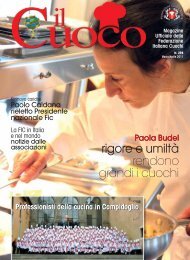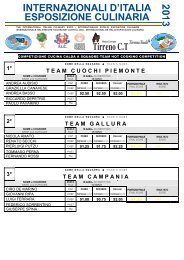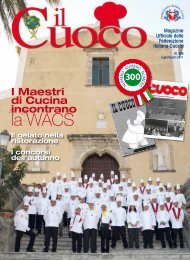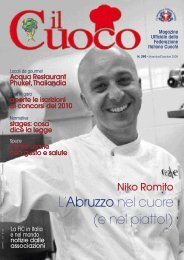N. 291 - Federazione Italiana Cuochi
N. 291 - Federazione Italiana Cuochi
N. 291 - Federazione Italiana Cuochi
Create successful ePaper yourself
Turn your PDF publications into a flip-book with our unique Google optimized e-Paper software.
ILCUOCOINTERNATIONAL<br />
SEE PAGE 20<br />
FOR THE ITALIAN TEXT<br />
Asparagus,<br />
the aristocrat<br />
by Sergio G. Grasso<br />
Alimentary Anthropologist<br />
A history spanning thousands of years and<br />
a taste appreciated by chefs of today and yesterday.<br />
Here are some useful things to<br />
know about this delicious spring vegetable<br />
Asparagus is a relative of grass, but above<br />
all a member of the lily family. Its Latin<br />
name Asparagus officinalis may derive<br />
from the ancient Persian word sh’beragh,<br />
i.e. “spear head”. And the plant – more<br />
correctly, the vegetable – with its edible<br />
parts composed of its shoots and turions<br />
and its particularly delicate taste -<br />
could come from the area of Persia between<br />
the Tigris and the Euphrates<br />
Known and appreciated by the ancient<br />
Egyptians, it was used by priests during<br />
sacrifices and religious celebrations to<br />
bathe the statues of the gods and the<br />
body of the Pharaoh with water from the<br />
Nile. Is it just a coincidence that the vegetable<br />
looks like the aspergillum still<br />
used today by priests to bless? And is it<br />
just a coincidence that “asparagus” and<br />
“aspergillum” also have such similar<br />
names? The History of Plants written by<br />
Theophrastus in the 4th Century B.C. is<br />
the first literary source on the asparagus.<br />
A century later, Cato described the<br />
plant according to the agronomic profile<br />
and after him Plinius proclaimed its<br />
gastronomic qualities proving that the<br />
area of Ravenna produced wild asparagus<br />
weighing one hundred grams each.<br />
The great naturalist illustrated in detail<br />
the cultivation method for which he did<br />
not show great enthusiasm: “nature<br />
wanted asparagus to be wild so that we could<br />
pick it, and now here we are with cultivated<br />
asparagus!”.<br />
WILD OR CULTIVATED<br />
A true delicacy of Roman times, the wild<br />
asparagus was so sought-after and expensive<br />
that they started to use surrogates,<br />
including bramble roots and the<br />
shoots of leeks, defined as “the asparagus<br />
of the poor”.<br />
The best natural asparagus of ancient<br />
times were picked on mountain slopes,<br />
such as those of the volcanic island of<br />
Nisida in the Gulf of Pozzuoli. Those<br />
which one Thursday Marziale offered to<br />
his guest, however, came from the<br />
Apennines, “mountain asparagus picked by<br />
a peasant”.<br />
The “usual” Apicus, on the other hand,<br />
recommended cooking it in two pans,<br />
changing the water twice to make them<br />
more compact. Then he suggested making<br />
patinae from them, a kind of purée<br />
with egg enriched with aromatic herbs<br />
and garum, a sauce made from fermented<br />
fish guts which must certainly<br />
have killed the special delicate taste of<br />
the asparagus.<br />
With the invasions of the Barbarians<br />
every trace of asparagus was lost from<br />
the books of cooking history. The Arabs<br />
re-introduced it into Spain at the time<br />
of the “conquistadores” (XIX century)<br />
and from there it reached France, in the<br />
areas surrounding Paris, Epernay and Bezons,<br />
but above all Argenteuil, which<br />
would become the home of the cultivated<br />
asparagus.<br />
During the Renaissance, the noble vegetable<br />
was frequently present at all banquettes<br />
and at all Spring feasts and was<br />
the symbol of reawakening nature. Even<br />
the members of the first colonies in<br />
North America would not forget to<br />
take with them some roots to replant<br />
and, still today, in Quebec, the asparagus<br />
is called “the aristocrat of vegetables”.<br />
Aristocracy which is also reflected<br />
in the price, because, whether they be<br />
wild or cultivated – the plant’s turions<br />
grow at different speeds and must be<br />
picked exclusively by hand.<br />
THE FRIEND OF HEALTH<br />
Its diuretic power has interested doctors<br />
for a long time (the second part of its scientific<br />
name “officinale”, recalls this<br />
property) and they also highly appreciate<br />
its prerogative of stimulating the appetite.<br />
Plato said: “eat asparagus at the beginning<br />
of a meal to alleviate inflammation<br />
of the stomach, to excite lust, heal pain of the<br />
eyes, strengthen sight, and gently soften the s-<br />
tomach and help you urinate. It is also useful<br />
against illness of the kidneys, stomach and<br />
intestine”. Outside the kitchen, the plant<br />
is used in cosmetics to prepare masks<br />
that invigorate the skin.<br />
The fact that the asparagus is so rich in<br />
phosphorous, vitamin A and oxalic acid<br />
is the reason why, in ancient times, it was<br />
attributed with aphrodisiac properties.<br />
This is a long-lasting conviction according<br />
to which, in the past, certain husbands<br />
seeking gallant adventures were<br />
found out by their wives because of asparagus,<br />
which “has the drawback of giving<br />
the urine a nauseating small, which, more than<br />
once, gave away the fact that the person had<br />
attended libertine dinners”. The smell of<br />
mercaptan in the urine after eating asparagus<br />
can be prevented following the<br />
advice of the Pilgrim Artusi at the end<br />
of the last century (in a period in which<br />
the presence of the “chamber pot was<br />
normal in every bedroom): “the unpleasant<br />
smell which asparagus gives to the urine<br />
can be converted into a pleasant fragrance by<br />
pouring a few drops of turpentine into the pot”.<br />
One of these days I must try it…<br />
USE IN THE KITCHEN<br />
After purchase, fresh asparagus must be<br />
kept at a low temperature, possibly in a<br />
medium-damp environment, if possible<br />
wrapped in a wet cloth leaving the tips<br />
uncovered. They should be eaten as<br />
soon as possible and, in any case, within<br />
twenty-four hours of purchase.<br />
In cooking, this vegetable gives a particular<br />
taste even to very simple dishes<br />
due to its good aromatic properties<br />
which, depending on the variety, can<br />
range from sweet to bitter and from<br />
grassy to “mineral”.<br />
Usually asparagus are eaten boiled in<br />
just a little water which under no circumstances<br />
must cover their tips (even<br />
better if they are steamed!). A popular<br />
method is to fry them in a frying pan<br />
with butter or to use them as an important<br />
ingredient in soups, quiches,<br />
creams, risottos, pies and omelettes.<br />
From the nutritional point of view, asparagus<br />
should be eaten without the<br />
usual accompaniment of condiments<br />
such as butter or together with foods<br />
such as eggs or cheese, given that these<br />
combinations make the product less digestible:<br />
improve them with a drop of excellent<br />
extra-virgin olive oil, a pinch of<br />
freshly-ground white pepper and a<br />
pinch of salt. Better not to use lemon but<br />
use a few drops of apple vinegar. If you<br />
like to eat them raw and crunchy, you<br />
78|
















